Only after a neighbor died of the coronavirus did Juan José and Esther Serralde begin to believe that the threat was real — but it was too late. Soon, the older couple, their son and daughter-in-law, and two of their grandchildren were infected.
Even if they had acted earlier, the family members might have struggled to protect themselves. Three generations share a home in a southern borough of Mexico City. The modest house opens onto a street market — and the family sells clothes right outside their door. Bedrooms double as storerooms. Every space was a potential play area for four kids.
The family's story helps explain why five months into Mexico’s COVID-19 epidemic, poor neighborhoods like San Gregorio Atlapulco persist as hot spots while other parts of the capital see a modest improvement.

One of the four daughters of Jose Juan Serralde rests on the bed in what was her grandparent's room until both died in May of COVID-19, in San Gregorio Atlapulco, Xochimilco, Mexico City, Wednesday, July 29, 2020. After Serralde's parents died nine days apart, the couple and their four daughters spent weeks quarantined at home, with most of them experiencing mild cases of COVID-19 before recovering. (AP PhotoRebecca Blackwell)
In San Gregorio and many places like it, fear of hospitals, deep-rooted distrust of authorities, difficulties accessing medical care, and the pressure to make a living amid economic uncertainty are fueling the spread of the virus.
“A lot of what is happening is because of how families are handling it,” said the Serraldes' son, José Juan, 47, who says his parents were skeptics and took few precautions, though he and his wife were more careful. Many people “don’t accept what is happening and don’t want to accept that they are dying of COVID.”
In the span of a month, José Juan Serralde buried his parents and an aunt, and fell ill himself and recovered, as did his wife and their daughters.
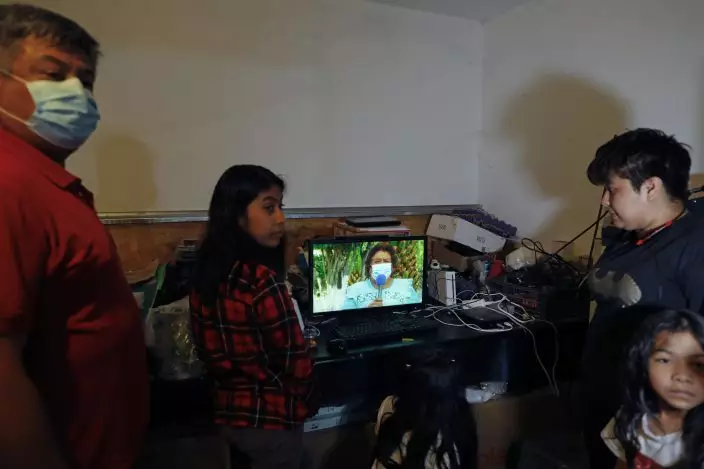
Jose Juan Serralde, left, and his daughters gather around a computer playing a video featuring his late mother, Esther Serralde Galicia, inside their home in San Gregorio Atlapulco, Xochimilco, Mexico City, Wednesday, July 29, 2020. After Serralde's parents died from COVID-19 in May, he, his wife, and their four daughters spent weeks quarantined in their home while some had mild cases of COVID-19 before recovering. (AP PhotoRebecca Blackwell)
“The family crypt filled up in less than a month,” he said.
Mexico has confirmed more than 443,000 infections and over 48,000 deaths — putting it in third place for fatalities worldwide.
Due to a lack of widespread testing, many deaths in Mexico remain uncounted. But a recently released report gives a sense of the scale of the outbreak: From April 19 to June 30, the capital city saw over 17,800 more deaths than usual.
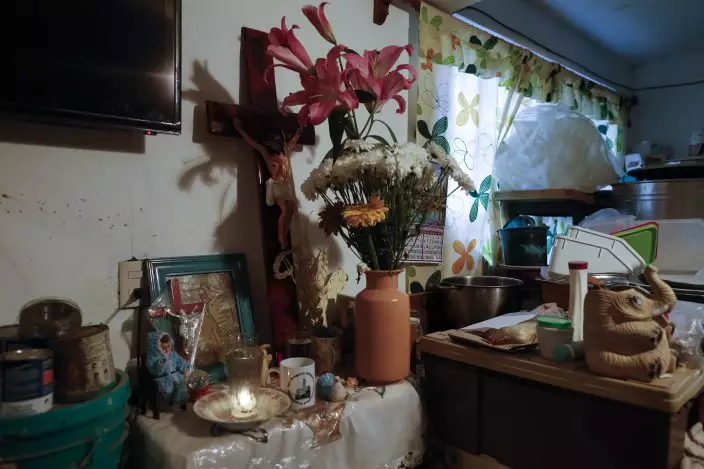
A pair of crosses stand alongside a candle and flowers, on a small altar dedicated to Jose Juan Serralde's parents who died in May from COVID-19, in the room where they lived in San Gregorio Atlapulco, Xochimilco, Mexico City, Wednesday, July 29, 2020. Mexico has confirmed more than 420,000 infections and over 46,000 deaths — putting it in third place for fatalities worldwide. (AP PhotoRebecca Blackwell)
Mexico recommended that people self-quarantine starting in mid-March. Serralde complied, and as a nonessential employee of the Xochimilco borough where he lives, stopped going to work. But his parents continued visiting markets to sell the plants they grew in a greenhouse, and they did not wear masks. The family continued to live in tight quarters.
Such living conditions are common in San Gregorio, an impoverished neighborhood of some 30,000 residents where it's common to see farmers in rubber boots pushing carts of produce from nearby fields. Large, multigenerational households and the fact that many people work in the informal economy mean it's hard for many residents to self-quarantine.
“You couldn’t isolate at home, we all shared the place,” said Serralde. “It was a mistake on our part, but no one explained it to us until after what happened to my dad.”
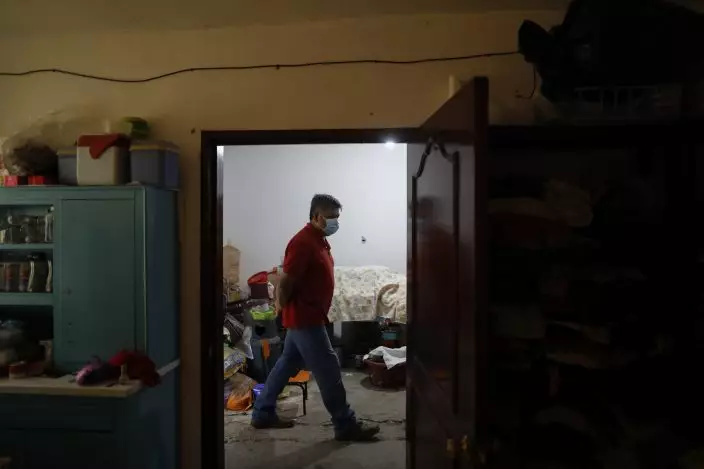
Jose Juan Serralde walks inside his home, which the family is still repairing and reinforcing following damage from a 2017 earthquake, in San Gregorio Atlapulco, Xochimilco, Mexico City, Wednesday, July 29, 2020. “You couldn’t isolate at home, we all shared the place,” said Serralde of his home where three generations lived. “It was a mistake on our part, but no one explained it to us until after what happened to my dad,” referring to his parents who died of COVID-19 in May. (AP PhotoRebecca Blackwell)
Mexican health officials have been holding daily televised news conferences about the pandemic for months. Still, they have given mixed messages on the necessity of wearing a mask, and President Andrés Manuel López Obrador himself has worn one only occasionally.
Serralde wasn’t sure how to implement health officials’ recommendations until a friend who is a doctor explained after his father died that the family should use disposable plates and plasticware, clean the bathroom with bleach after each person used it, and get everyone in the house, except his youngest daughter, tested.
By June, Mexico City Mayor Claudia Sheinbaum had paired a cautious reopening with expanding testing and contact tracing. In July, she added an information campaign that sent government workers door to door in the most affected areas. The city of about 10 million — with another 10 million living in the surroundings — is now testing about 4,000 people a day.
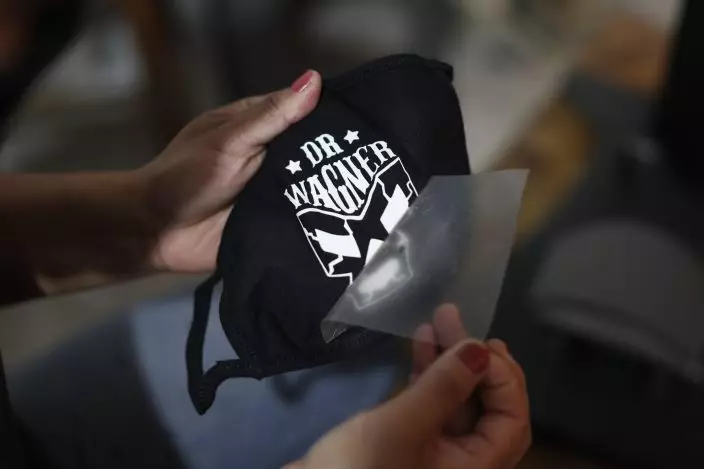
Blanca Evangelista Villada peels off the plastic after ironing an image of a wrestler's logo onto a cloth face mask, which she sells for 15 pesos each (about 65 cents) to supplement the family's income after her tee-shirt business was declared non-essential during the coronavirus pandemic in San Gregorio Atlapulco, Xochimilco, Mexico City, Wednesday, July 29, 2020. Evangelista's husband, whose parents lived with them and died of COVID-19 in May, acknowledges that his family didn't take enough precautions and now tries to persuade everyone to take such measures, but he also believes authorities need to be more strict. (AP PhotoRebecca Blackwell)
But these efforts came too late for the Serralde family. At the beginning of May, they learned their neighbor had died of the virus. Soon after, Serralde's 73-year-old father developed diarrhea and his 69-year-old mother complained of pain around her kidneys. Neither's symptoms made the family suspect COVID-19.
By the time they buried the older man, half the family had symptoms. Serralde's mother began to struggle to breathe.
But she was afraid to go to the hospital because of the common belief that those who go in never come out, her son explained.
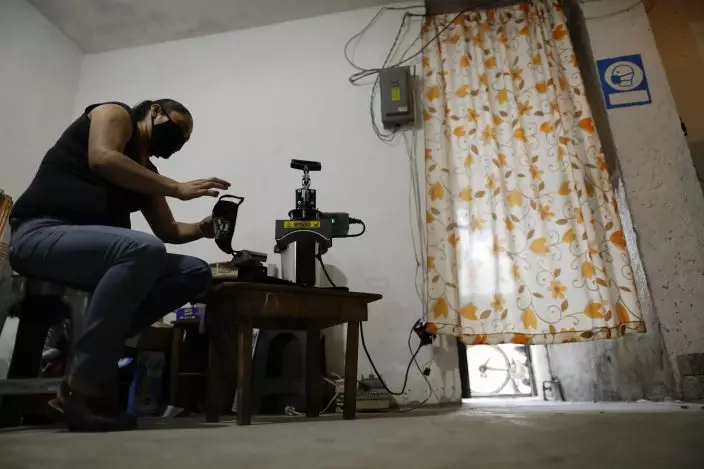
Blanca Evangelista Villada uses a machine to iron decorative designs onto face masks which she sells for 15 pesos each (about 65 cents) to supplement the family's income after her tee-shirt business was declared non-essential during the coronavirus pandemic, in San Gregorio Atlapulco, Xochimilco, Mexico City, Wednesday, July 29, 2020. In the span of a month, Evangelista and her husband buried his parents and an aunt who died of COVID-19, and fell ill themselves along with their daughters but recovered. (AP PhotoRebecca Blackwell)
Dr. Jorge Esteban Ballesteros, director of the San Gregorio Health Center, said such neighborhoods are often hotbeds of distrust and misinformation, creating the perfect conditions for the epidemic to grow.
“It’s a difficult population of deeply rooted customs, resistant toward authority, who say the virus is something made up by the government,” Ballesteros said. “They’ve even said we’re spreading the virus as we sanitize.”
Serralde still breaks down thinking about trying to navigate the health system while also suffering from the illness.

FILE - In this July 24, 2020 file photo, workers spray a disinfectant solution on a street in San Gregorio Atlapulco in the Xochimilco district of Mexico City, amid the new coronavirus pandemic. In San Gregorio and many places like it, fear of hospitals, deep-rooted distrust of authorities, difficulties accessing medical care, and the pressure to make a living amid economic uncertainty are fueling the spread of the virus. (AP PhotoRebecca Blackwell, File)
When the family finally convinced the older woman to go to the hospital, they struggled to find one that would take her. A military hospital turned them away, and they ended up in a hard-hit neighboring borough.
Once she was hospitalized, the family had to secure an oxygen mask because the hospital did not have one — and they even had to hunt down their own acetaminophen.
Ballesteros, the doctor, says authorities need to reinforce the measures they have taken, like providing more economic support to struggling families, expanding testing and continuing to knock on doors to give information in hard-hit neighborhoods.
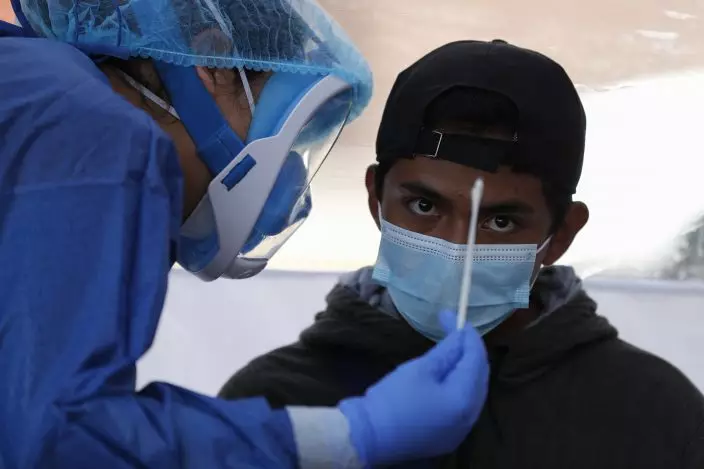
FILE - In this July 24, 2020 file photo, Dr. Diana Pacheco explains to a patient that she will collect nasal and throat swabs, during walk-up COVID-19 testing in a mobile diagnostic tent, in San Gregorio Atlapulco in the Xochimilco district of Mexico City, Friday, July 24, 2020. The capital's health secretariat erected mobile testing units in the areas of the city hardest hit by the coronavirus pandemic, but only limited numbers of testing kits are available each day. (AP PhotoRebecca Blackwell, File)
Serralde acknowledges that his family didn't take enough precautions and now tries to persuade everyone to take such measures — his wife is even selling masks — but he also believes authorities need to be more strict. For instance, he wishes they would enforce the virus-control measures that businesses are supposed to implement and make face masks mandatory.
“I feel like this is slipping out of the hands of the government, the mayor, the president, everyone,” he said.
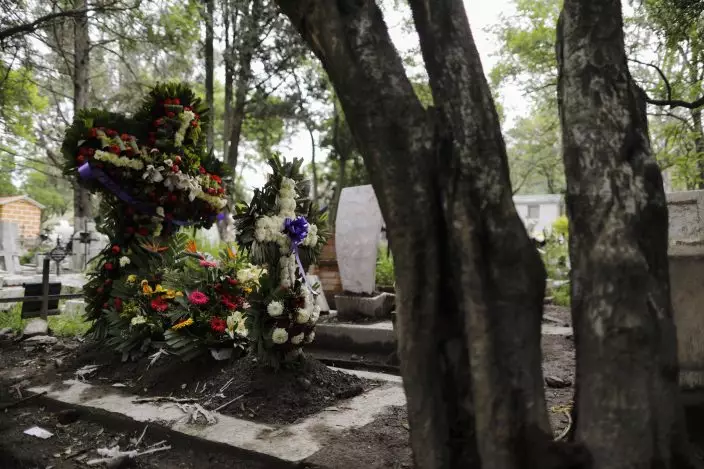
FILE - In this July 27, 2020 file photo, crosses of fresh flowers adorn a new grave at Xilotepec Cemetery amid the new coronavirus pandemic, in Xochimilco, Mexico City. From April 19 to June 30, the capital city saw over 17,800 more deaths than usual. (AP PhotoRebecca Blackwell, File)
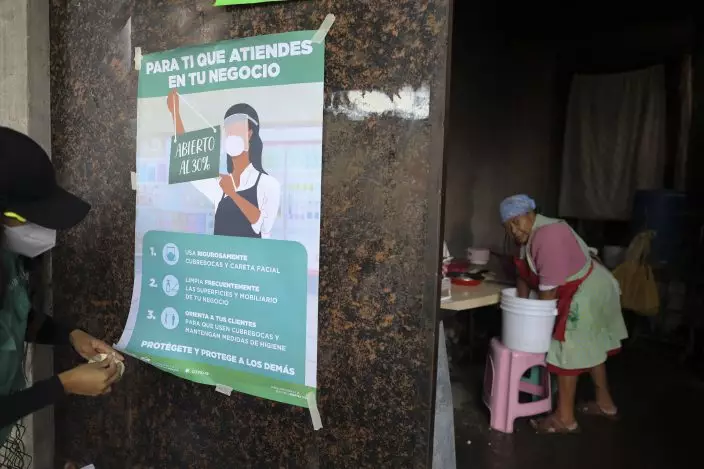
FILE - In this July 21, 2020 file photo, a city health department worker hangs a poster describing the guidelines for businesses operating during the coronavirus pandemic, as a woman prepares to make tortillas inside a small business, in San Mateo Xalpa in the Xochimilco district of Mexico City. Mexican health officials have been holding daily televised news conferences about the pandemic for months, but they have given mixed messages on the necessity of wearing a mask. (AP PhotoRebecca Blackwell, File)
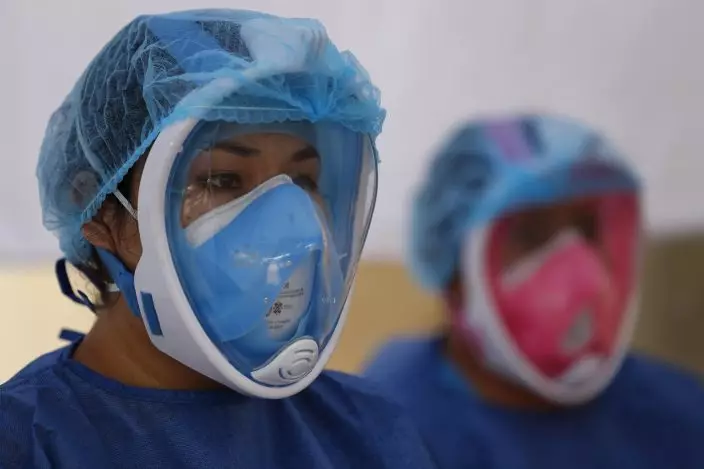
FILE - In this July 24, 2020 file photo, Dr. Diana Pacheco, left, and nurse Claudia Flores Martinez prepares to attend to their next patient, as they conduct COVID-19 testing inside a mobile diagnostic tent, in San Gregorio Atlapulco in the Xochimilco district of Mexico City, Friday, July 24, 2020. The city of about 10 million — with another 10 million living in the surroundings — is now testing about 4,000 people a day. (AP PhotoRebecca Blackwell, File)
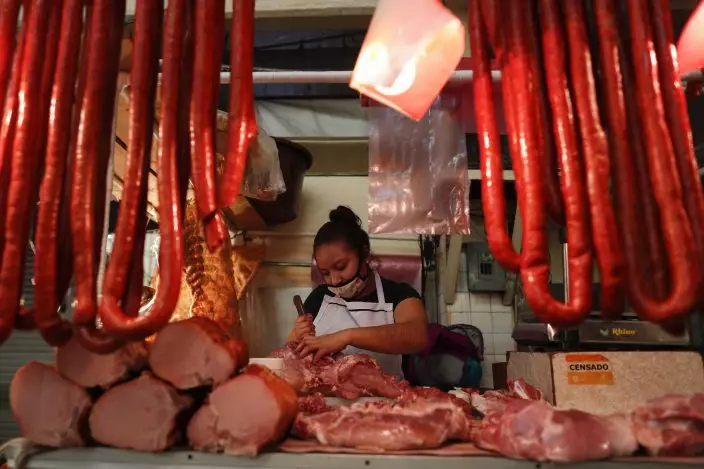
FILE - In this May 15, 2020 file photo, a butcher wears a mask as she works inside a public market in the Xochimilco district of Mexico City. Fear of hospitals, deep-rooted distrust of authorities, difficulties accessing medical care, and the pressure to make a living amid economic uncertainty are fueling the spread of COVID-19 in this southern borough of the capital. (AP PhotoRebecca Blackwell, File)
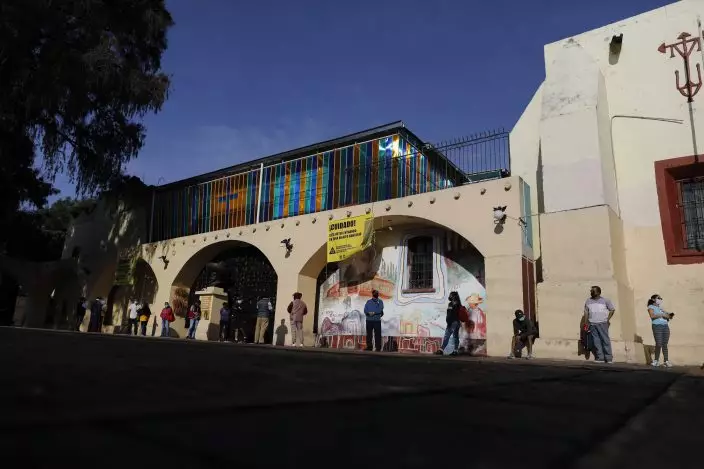
FILE - In this July 24, 2020 file photo, people stand at a distance as they wait in line to get a COVID-19 test at a mobile diagnostic tent in San Gregorio Atlapulco in the Xochimilco district of Mexico City. Five months into Mexico’s COVID-19 epidemic, poor neighborhoods like San Gregorio Atlapulco persist as hot spots, where large, multigenerational households and the fact that many people work in the informal economy mean it's hard for many residents to self-quarantine. (AP PhotoRebecca Blackwell, File)

Jose Juan Serralde and his wife Blanca Evangelista Villada walk into their home's front hall in San Gregorio Atlapulco, Xochimilco, Mexico City, Wednesday, July 29, 2020, after his parents died of COVID-19 in May while living with them. Serralde wasn’t sure how to implement health officials’ recommendations until a friend who is a doctor explained after his father died that the family should use disposable plates and plasticware, clean the bathroom with bleach after each person used it, and get everyone in the house, except his youngest daughter, tested. (AP PhotoRebecca Blackwell)

Blanca Evangelista Villada wears a mask amid her four daughters in the front room of their home in San Gregorio Atlapulco, Xochimilco, Mexico City, Wednesday, July 29, 2020. Only after a neighbor died of the coronavirus did Evangelista's in-laws begin to believe that the threat of COVID-19 was real. Soon, the older couple, their son and daughter-in-law, and two of their grandchildren were infected. Evangelista's in-laws, who lived with them, died in May. (AP PhotoRebecca Blackwell)
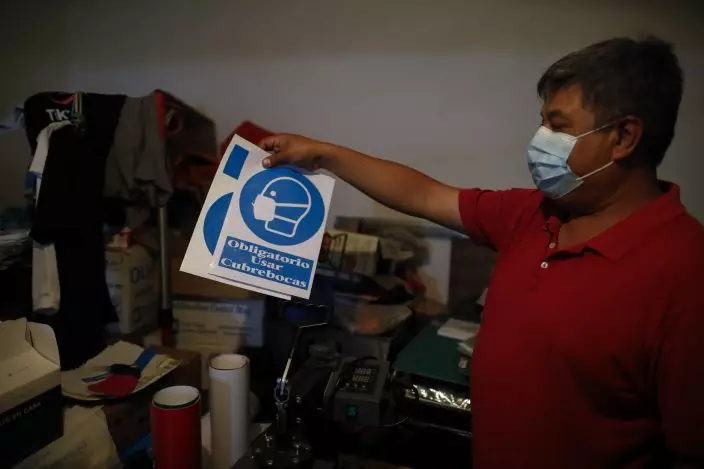
Jose Juan Serralde holds up decals his family prints and sells to neighboring businesses, showing a figure with a face mask with the Spanish slogan "Using a face mask is obligatory," at his home where his parents fell ill of COVID-19 and died two months prior, in San Gregorio Atlapulco, Xochimilco, Mexico City, Wednesday, July 29, 2020. Serralde said he wishes authorities would enforce the virus-control measures that businesses are supposed to implement and make face masks mandatory. “I feel like this is slipping out of the hands of the government, the mayor, the president, everyone,” he said. (AP PhotoRebecca Blackwell)
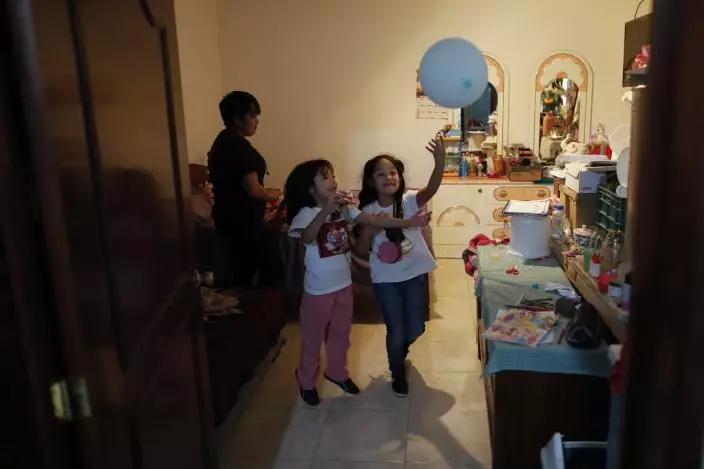
Jose Juan Serralde's daughters play in the room where his parents lived until their deaths in May from COVID-19, in San Gregorio Atlapulco, Xochimilco, Mexico City, Wednesday, July 29, 2020. Mexico recommended people self-quarantine starting in mid-March, but the elderly couple continued visiting markets to sell the plants they grew in a greenhouse, and they did not wear masks, while the family continued to live in tight quarters where most of the family got COVID-19, but recovered. (AP PhotoRebecca Blackwell)


